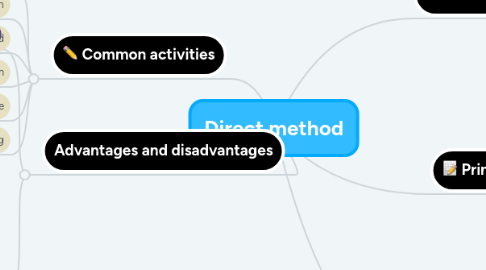
1. Common activities
1.1. Question/answer exercise
1.2. Dictation
1.3. Reading aloud
1.4. Student self-correction
1.5. Conversation practice
1.6. Paragraph writing
2. Advantages and disadvantages
2.1. Advantages
2.1.1. The focus is on Oral Practice. Therefore, the pronunciation improves.
2.1.2. In teaching vocabulary such as words, idioms, this method is good
2.1.3. Helps the learners in having good fluency
2.1.4. It makes the teaching English easier and more pleasant. A teacher uses various images/ pictures to illustrates a point
2.1.5. Students learn to speak complete sentences without any hesitation.
2.2. Disadvantages
2.2.1. Owing to over-emphasis on oral practice, the other skills namely reading and writing are ignored to a great extent.
2.2.2. In the early stage of learning, this method is completely unsuccessful.
2.2.3. The background at home must also be foreign language friendly for this method.
2.2.4. May not hold well in higher-level classes where the translation method is more suitable
2.2.5. Needs skilled teachers
3. Characteristics and origins
3.1. Origins
3.1.1. -
3.1.2. The Direct Method, also called Natural Method, was established in Germany and France around 1900. It appeared as an answer to the shortcomings of the Grammar Translation Method.
3.2. Characteristics
3.2.1. Teaching concepts and vocabulary through pantomiming, real life objects and other visual material
3.2.2. Centrality of spoken language
3.2.3. Teaching grammar by using an inductive approach
3.2.4. Focus on question-answer patterns
3.2.5. Uses only the target language
4. Principles
4.1. Only the target language is used
4.2. Speaking is supreme
4.3. Language is learned inductively
4.4. Grammar is taught inductively.
4.5. Direct relation between thought and words
4.6. Limited Vocabulary
4.7. Sentence as the unit of speech
5. Roles
5.1. .
5.1.1. Roles of teacher
5.1.1.1. Direct class activities
5.1.1.2. Encourage students to participate in class by asking them questions
5.1.1.3. Correct mistakes immediately
5.1.1.4. Use examples, images and gestures to make students understand the topic
5.1.2. Roles of student
5.1.2.1. Observation and practice
5.1.2.2. Active role in activities
5.1.2.3. Use of target language all class
